This blog post is not only an update for those curious about the going's on, but also to serve as notes for how we prep the hives this fall. What's nice about a blog is that is kind of a nice notebook. Also, Mr. Neil would like an update on our bees while he is traveling the world. After last year when our bees were okay in February and then dying in March, moisture appeared to be part of the problem, so we tried a variety of solutions. One being Mr. Neil's groundskeeper named Hans went out and cleared snow away from the bottom entrances. We also had him go ahead and remove the insulation, last year was a colder winter and we left it on longer. But the bees had been quite active and it's been so warm (it hit 60 degrees yesterday) that Hans took it off last week. We didn't put the insulation on until late last fall, they should be able to take it if we dip down into the twenties again.
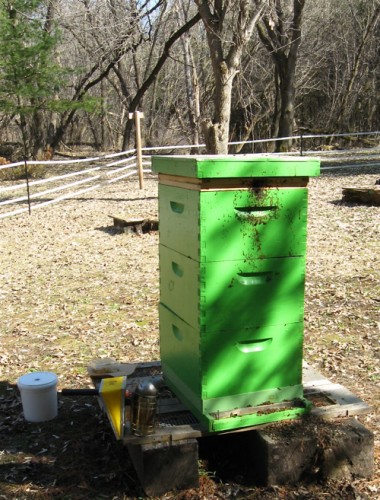
The green hive was three deep brood boxes this winter which is what I was taught we should do at the University of Minnesota's beekeeping short course. She's been fairly noisy all winter. The bees had taken advantage of the warm days and pooped up a storm (they don't poop in the hive so hold it up all winter and then let her rip on warm spring days). We used a wooden entrance reducer on her--to control the flow of air from below and prevent mice from entering the hive. She also had a piece of board on top, above the ceiling to absorb moisture during the winter. It appeared to have worked, there was a little moisture on the board, a little mold, but none on the ceiling or top of the brood box itself.
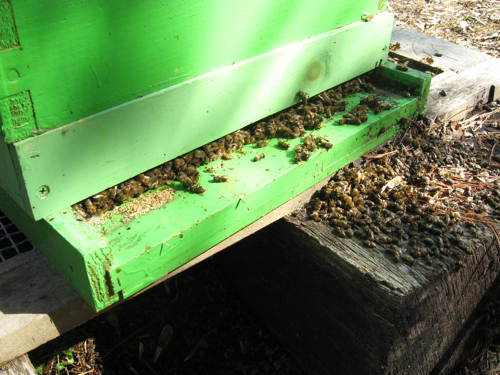
This hive also has a slatted rack which is supposed to discourage swarming. Also a beekeeper told me that it's somehow supposed to aid in ventilation. I'm not sure, I think it's one of those things where a beekeeper noticed less moisture in the hive when they have had it in there. I took out the entrance reducer and used my hive tool to clear out some of the dead bees at the bottom to help with air flow and give the girls more room to work. The bodies were wet, I cleared out the bee pieces until a few live workers flew out from the bottom. There was a nice, noisy active cluster of bees at the top of the hive. I placed a feeder pail of nectar on top and added a pollen patty to help get them trough the next couple of weeks. I tweaked all the pollen patties this time with a little actual honey from our stores. I also brought each hive a piece of comb honey, more for my own benefit than anything else, kind of like a hive warming present.
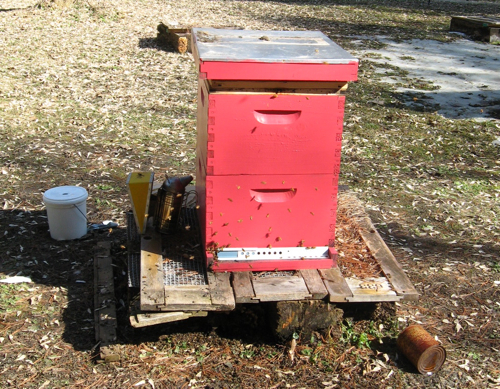
This was a hive I did not expect to survive the winter. She swarmed late in the summer last and I let her do it-- no heroic measures to stop it, even though I thought it a bad move on her part. She went into the winter with just two brood boxes of food and a very small cluster. Some beekeepers do keep their hives down to a 2 box system in winter--even our neck of the woods so she had a chance. She was one of the most active hives I visited yesterday. The green hive had the most workers moving in and out of the entrance, this one had the second largest highway going. I even took some video down by her opening at the metal entrance reducer. If you watch at the bottom left at the beginning you might notice a worker removing a dead body:
[youtube]http://www.youtube.com/watch?v=ExVV-pN1cNA[/youtube]
Impressive activity! I left on her entrance reducer because the bees seemed to be getting out at the bottom and top easily. Mice are still somewhat of an issue but the reducer will probably come off in early April if the weather holds.
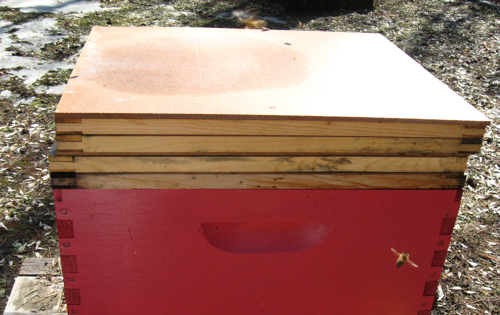
This hive does not have a slatted rack on the bottom but has four inner covers on the top and the moisture board. If you look at the board on top--it has a wet spot. I'd say it did it's job rather well. The ceilings were dry inside this hive which I think aided in her survival.
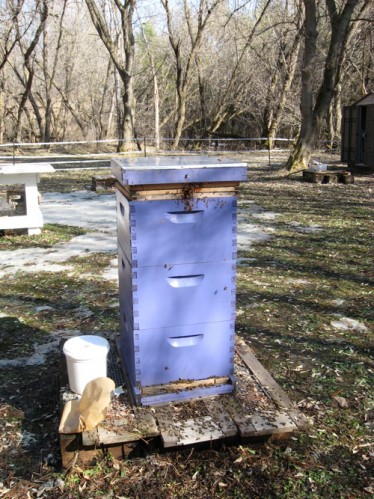
The purple hive was a wee bit quieter but still active. She went into the winter with three deep brood boxes, moisture board, double ceilings but no slatted bottom.
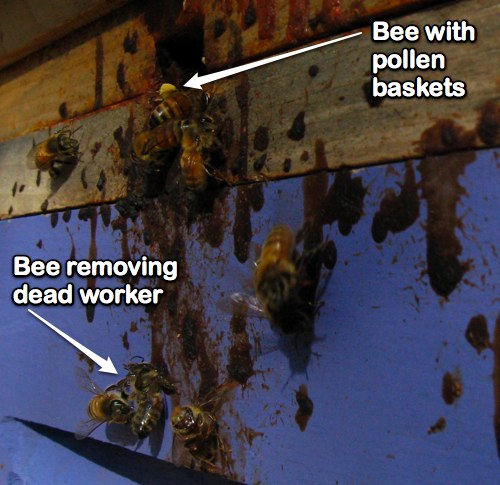
The workers were not coming out of the bottom, but using the top hole to poop, remove some dead bees and if you look closely you can see a forager returning with some yellow pollen baskets!
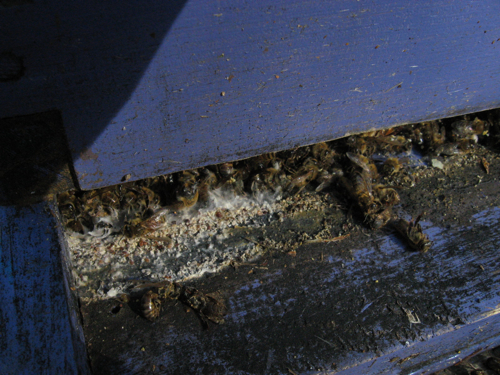 When I removed the entrance reducer, some of the dead, wet bees at the entrance had grown some fungus. It was just at the entrance and scraped out piles of dead bees from the bottom until a few live ones flew out. There was a good ball of bees at the top and they were very excited about the feeder pail and pollen patty.
When I removed the entrance reducer, some of the dead, wet bees at the entrance had grown some fungus. It was just at the entrance and scraped out piles of dead bees from the bottom until a few live ones flew out. There was a good ball of bees at the top and they were very excited about the feeder pail and pollen patty.
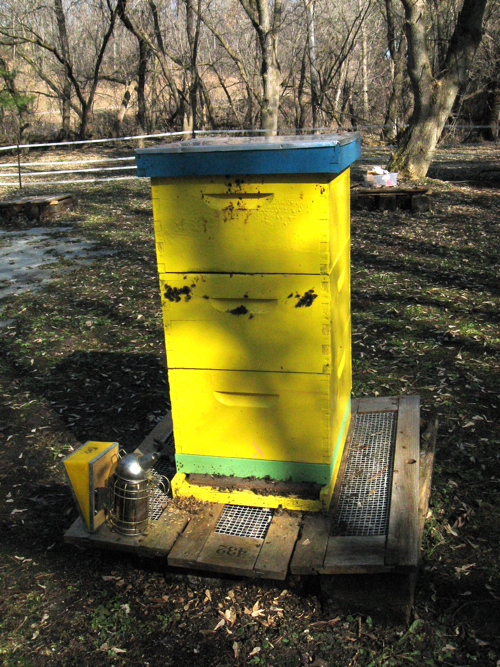
I wasn't sure what to expect of this hive. She'd been fairly quiet all winter. You had to really press your ear up to the insulation to hear anything. Her exit hole at the top of the hive was smaller than the others (barely enough room for one bee to come out and no one ever seemed to come out of the bottom. She had three deep brood boxes, a wooden entrance reducer, a slotted bottom and a moisture board. Bees took turns coming in and out of the top entrance. I opened the top and she was very lively. I put up the feeder pail and pollen patty. You can see a video here (and see a worker come in with loaded pollen baskets while the others nom the feeder pail and nom nom nom the pollen patty.
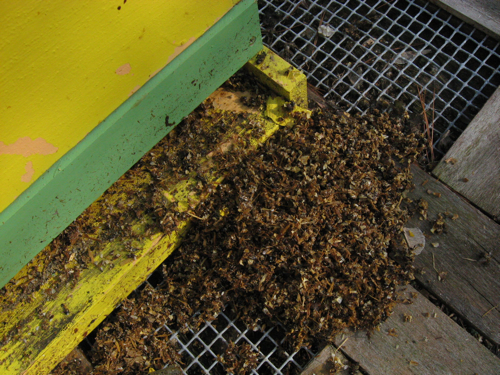
After I removed the entrance reducer and started to scrape out debris, I couldn't help but notice that there were very few bee parts and an awful lot of wood shavings. This did not look good. I had a suspicion of what was going down--a mouse had moved into the hive for the winter. Bastard! The bees had a good harmonious hum going and this was a three deep box. I wondered if maybe the mouse had kept to the bottom while the bees were on top? Was this hive through or could it be saved? I had no choice, I had to open her up.

The mouse did not chew up from the base, it looked like it squeeze right through the tiny hole left by the wooden entrance reducer. Then chewed through the slatted bottom and made its nest there. The mouse worked it's way into the bottom brood box and ate quite a bit of the honey and wax, however it did not appear to have gone up into the top two brood boxes and there was still some food left there.
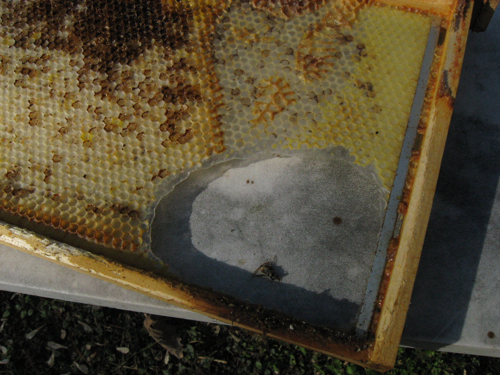
The mouse had chewed into the wax foundation of some of the bottom frames (hope it got a good tummy ache). Looking at photos of other mice in beehive stories, this is typically where the mouse builds the nest. Did this mouse get interrupted? I scraped out the bottom board and found no mouse--not even a propolis covered mouse mummy.
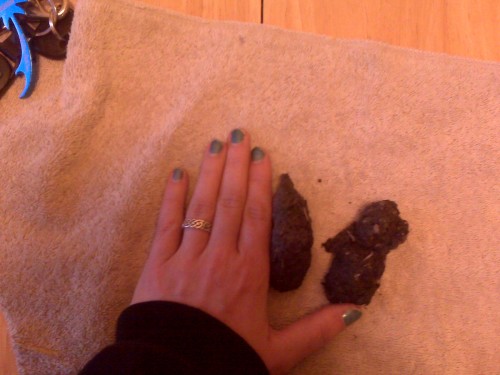
I did find a couple of ginormous owl pellets near the hives. Perhaps the local great horned owl took care of the mouse for me? Maybe I'll find it's skull when I dissect these?
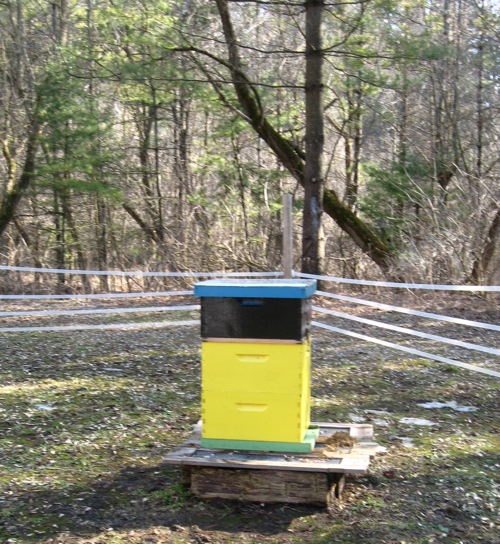
The hive otherwise seemed healthy. I replaced the base board, and removed the bottom box, making this a two brood box hive like the red hive. I put a third and empty box over the feeder pail and pollen patty. I'll be curious to see how this hive does over the next two weeks.
I always knew mice were a possibility and we've had them try and get in the hives before when we find their telltale tracks in the snow leading to the entrances. Usually a well placed snap trap does the trick but this time we didn't see any tracks. The good news is that all four hives are still going and appear to be ready for this summer's honey production. We'll feed all four for as long as they seem to need it.
